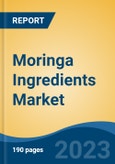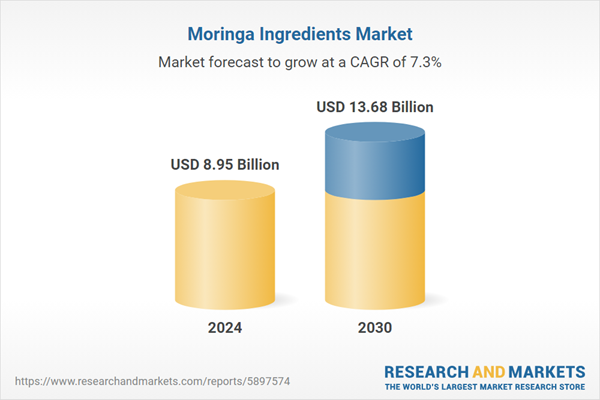Speak directly to the analyst to clarify any post sales queries you may have.
10% Free customizationThis report comes with 10% free customization, enabling you to add data that meets your specific business needs.
Another significant driver is moringa's expanding use in cosmetics and personal care products. Moringa oil, known for its anti-inflammatory and moisturizing properties, is being used in facial serums, creams, shampoos, and soaps. The rise of natural and organic beauty trends, coupled with consumer distrust in synthetic ingredients, has accelerated the adoption of moringa in skincare. Additionally, its antioxidant properties make it a valuable ingredient in anti-aging products, further boosting its relevance in the beauty industry.
Key Market Drivers
Rising Demand for Natural and Organic Products
The rising consumer preference for natural and organic products is a key driver of growth in the moringa ingredients market. A recent global survey found that 60% of consumers prefer products with recognizable, natural ingredients, while over 70% of beauty shoppers are actively seeking clean-label skincare solutions. Moringa, with its dense nutritional profile and adaptability to organic farming, fits perfectly into this demand. Rich in antioxidants, vitamins, and amino acids, it is increasingly featured in dietary supplements, health drinks, and fortified snacks.Moringa’s diverse applications extend into cosmetics, personal care, and herbal wellness. Its seed oil, known for its hydrating and anti-aging properties, is now widely used in moisturizers, serums, and shampoos. Moringa leaf extracts are gaining popularity in face masks and herbal teas due to their detoxifying benefits. As more consumers turn away from synthetic ingredients, moringa provides a natural alternative that meets expectations for both performance and sustainability across multiple product categories.
Beyond its product appeal, moringa also aligns with ethical and sustainable sourcing values. Its drought resistance and ability to grow in poor soils reduce environmental impact, making it ideal for low-input organic farming systems. Coupled with fair-trade initiatives and transparent supply chains, moringa ingredients meet the increasing consumer demand for eco-friendly, socially responsible products. These characteristics, combined with moringa’s functional versatility, continue to drive its adoption across global natural and organic product segments.
Moringa's inclusion in the functional foods and wellness nutrition category further reinforces its market appeal. With the growing popularity of plant-based and superfood-enriched products, moringa is being added to energy bars, protein powders, herbal teas, and meal replacements. Its high content of calcium, iron, and vitamin C positions it as a strong contender for addressing nutritional deficiencies, especially among vegan and vegetarian populations. As consumers seek convenient ways to meet daily nutrient needs, moringa’s functional benefits make it a go-to ingredient in health-oriented product innovations.
Key Market Challenges
Supply Chain Issues
One of the critical challenges facing the global moringa ingredients market is the vulnerability of its supply chain. Moringa is primarily cultivated in regions with tropical and subtropical climates, such as India, Africa, and Southeast Asia. However, the lack of standardized farming practices, limited infrastructure, and inconsistent quality control measures in these regions often disrupt supply reliability. Seasonal variations, unpredictable weather patterns, and logistical inefficiencies further contribute to delays and shortages.In addition, post-harvest handling, drying, and processing of moringa require specific conditions to maintain nutrient quality. Many small-scale producers lack access to advanced processing technologies, resulting in variations in product consistency, contamination risks, or nutrient loss. This makes it difficult for global buyers, especially in the nutraceutical and food industries, to source high-quality, certified ingredients consistently.
Moreover, international trade barriers, regulatory hurdles, and rising transportation costs have amplified supply chain stress. Import-export regulations, especially concerning organic certification and phytosanitary standards, can delay shipments or result in product rejections. As demand continues to rise globally, these supply chain bottlenecks threaten the steady availability of moringa ingredients, impacting manufacturers’ ability to scale production and maintain product quality across regions.
Key Market Trends
Expanding Cosmetics and Personal Care Segment
The global cosmetics and personal care segment are undergoing a transformation which is a major trend, driven by consumer preferences for natural and sustainable beauty products. Within this dynamic landscape, moringa ingredients have emerged as a significant contributor to the industry's growth. Known as the "miracle tree," moringa offers an array of benefits that align perfectly with the evolving demands of consumers. Moringa's allure extends beyond its nutritional value; it is also prized for its beauty-enhancing properties. Moringa oil, extracted from the seeds of the moringa tree, is a particularly valuable ingredient in the cosmetics and personal care industry.Rich in antioxidants, vitamins, and fatty acids, moringa oil nourishes the skin and hair, making it an ideal addition to a wide range of beauty products. Consumers today are increasingly scrutinizing the ingredients in their beauty products, seeking natural and organic alternatives to traditional formulations laden with synthetic chemicals. Moringa aligns perfectly with this shift in preferences, as it is cultivated using sustainable and organic farming practices, avoiding the use of harmful pesticides and chemicals. Moringa oil's moisturizing properties make it a coveted ingredient in skincare products such as lotions, creams, serums, and moisturizers.
Its lightweight texture ensures quick absorption without leaving a greasy residue, making it suitable for all skin types. Moringa oil hydrates and nourishes the skin, promoting a healthy, radiant complexion. The skin is constantly exposed to environmental stressors that can lead to premature aging. Moringa oil's high antioxidant content, including vitamin E and beta-carotene, provides protection against free radicals, reducing the risk of oxidative damage, fine lines, and wrinkles. Consumers are increasingly seeking products that offer these protective qualities. Moringa's benefits extend to hair care products as well. Moringa oil strengthens hair strands, promotes hair growth, and prevents split ends.
Its use in shampoos, conditioners, hair masks, and serums has gained popularity among those looking for natural solutions to achieve healthy and lustrous locks. The beauty industry is not just about products but also about the ethical and sustainable practices of the companies producing them. Moringa's eco-friendly cultivation practices, such as its ability to thrive in diverse climates with minimal water requirements, make it a sustainable choice. Ethical sourcing and fair-trade initiatives further enhance the appeal of moringa products among conscious consumers. Moringa is a global ingredient, cultivated in regions with tropical and subtropical climates. This global presence ensures a steady supply of high-quality moringa ingredients to meet the demand of cosmetics and personal care manufacturers worldwide.
Report Scope:
In this report, the Global Moringa Ingredients Market has been segmented into the following categories, in addition to the industry trends which have also been detailed below:Moringa Ingredients Market, By Source:
- Leaves
- Seed
- Roots
- Flowers
- Others
Moringa Ingredients Market, By Origin:
- Organic
- Conventional
Moringa Ingredients Market, By Application:
- Food & Beverages
- Pharmaceuticals
- Cosmetics & Personal Care
- Others
Moringa Ingredients Market, By Region:
- North America
- United States
- Canada
- Mexico
- Europe
- Germany
- United Kingdom
- France
- Italy
- Spain
- Asia-Pacific
- China
- Japan
- India
- Australia
- South Korea
- South America
- Brazil
- Argentina
- Colombia
- Middle East & Africa
- South Africa
- Saudi Arabia
- UAE
- Kuwait
Competitive Landscape
Company Profiles: Detailed analysis of the major companies present in the Global Moringa Ingredients Market.Available Customizations:
With the given market data, the publisher offers customizations according to a company's specific needs. The following customization options are available for the report.Company Information
- Detailed analysis and profiling of additional market players (up to five).
This product will be delivered within 1-3 business days.
Table of Contents
Companies Mentioned
- Organic India Pvt Ltd
- EARTH EXPO COMPANY
- Kuli Kuli Inc
- Ancient Greenfields PVT LTD
- Grenera Nutrients Private Limited
- Botanica Natural Products
- Aayuritz Phytonutrients Pvt.Ltd.
- HNCO Organics Private Limited
- Moringa Initiative
- Green Virgin Products
Table Information
| Report Attribute | Details |
|---|---|
| No. of Pages | 186 |
| Published | August 2025 |
| Forecast Period | 2024 - 2030 |
| Estimated Market Value ( USD | $ 8.95 Billion |
| Forecasted Market Value ( USD | $ 13.68 Billion |
| Compound Annual Growth Rate | 7.2% |
| Regions Covered | Global |
| No. of Companies Mentioned | 10 |









